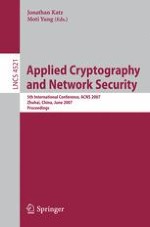2007 | Buch
Applied Cryptography and Network Security
5th International Conference, ACNS 2007, Zhuhai, China, June 5-8, 2007. Proceedings
herausgegeben von: Jonathan Katz, Moti Yung
Verlag: Springer Berlin Heidelberg
Buchreihe : Lecture Notes in Computer Science
